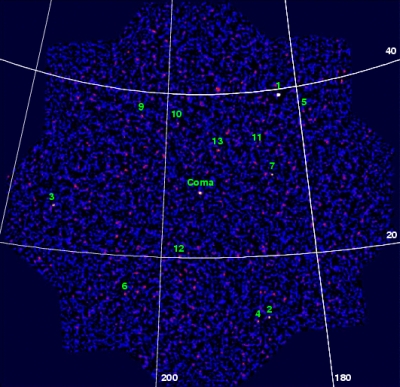INTEGRAL in the Journals
16 August 2005
A number of interesting papers have recently been published based on data gathered by INTEGRAL - ESA's gamma-ray observatory. They cover a range of observations covering all the capabilities of the spacecraft.INTEGRAL IBIS observation of the Coma Cluster
Krivonos et al., ApJ 2005, 625, 89.
This image shows a 500 ks IBIS observation of the Coma Cluster region in the 20 to 50 keV range. In addition to the Coma Cluster itself the image shows 12 serendipitous sources with more than 4 sigma significance. The faintest sources in this image are about 1 mCrab.
A large fraction of the identified sources are low redshift (z < 0.02) AGN's, mostly of Seyfert I type. The source in the image directly account for about 3% of the cosmic X-ray background in the 20-50 keV band.
 |
|
Krivonos et al. (IKI, Moscow) |
The 1-50 keV spectral and timing analysis of IGR J18027-2016: an eclipsing, high mass X-ray binary
Hill, A., et al., A&A, Volume 439, Issue 1, August III 2005, pp.255-263
We report the association of the INTEGRAL source IGR J18027-2016 with the BeppoSAX source SAX J1802.7-2017. IGR J18027-2016 is seen to be a weak, persistent source by the IBIS/ISGRI instrument on board INTEGRAL with an average source count rate of 0.58 counts s-1 (6.4 mCrab) in the 20-40 keV band. Timing analysis performed on the ISGRI data identifies an orbital period of of 4.5696 ± 0.0009 days and gives an ephemeris of mid-eclipse as, T_mid = 52 931.37 ± 0.04 MJD.
The 1st INTEGRAL SPI-ACS gamma-ray burst catalogue
Rau, A., et al., A&A, Volume 438, Issue 3, August II 2005, pp.1175-1183
We present the sample of gamma-ray bursts detected with the anti-coincidence shield ACS of the spectrometer SPI on-board INTEGRAL for the first 26.5 months of mission operation (up to Jan. 2005). SPI-ACS works as a nearly omnidirectional gamma-ray burst detector above ~80 keV but lacks spatial and spectral information. In this catalogue, the properties derived from the 50 ms light curves (e.g., T90, Cmax, C_int, variability, V/Vmax) are given for each candidate burst in the sample. A strong excess of very short events with durations <0.25 s is found. This population is shown to be significantly different from the short- and long-duration burst sample by means of the intensity distribution and V/Vmax test and is certainly connected with cosmic ray hits in the detector. A rate of 0.3 true gamma-ray bursts per day is observed.
